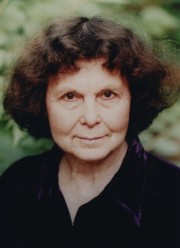At the present moment
Composer Sophia Gubaidulina first discussed her violin concerto, In tempus praesens, with Anne-Sophie Mutter, the violinist who commissioned the work and to whom it is dedicated, one hour before their first rehearsal for its world premiere at the Lucerne Festival in 2007. During that hour, Mutter played the entire violin part of the 33-minute piece.
According to the composer, Mutter’s playing had such depth of understanding and precision of technique that it was musically perfect. Gubaidulina describes it as “the happiest moment of my life.”
For the last two weeks San Francisco audiences have been able to share in the Russian composer’s musical vision during her tenure as the first Phyllis C. Wattis Composer in Residence at the San Francisco Symphony. In the first week, the symphony presented a recent symphonic work, The Light of the End, as well as a chamber piece. The second week of the residency opened with the North American premiere of In tempus praesens with the San Francisco Symphony and Anne-Sophie Mutter performing. Michael Tilson Thomas conducted.
In tempus praesens is a violin concerto, but it is conceived of differently from most concertos, which are built on the Romantic model of the hero, represented by the instrument, facing the incalculable and grand forces of nature, represented by the orchestra. In this piece of five movements melded into one, the composer describes the violin as the “instigator,” leading the other instruments in a kind of spiritual creation. Illustrative of the violin’s preeminence is the fact that there are no other violins in the orchestra, although, there are the lower-voiced strings—violas, cellos, and basses.
The piece begins with a long violin solo, which cascades into a hum like that of an industrious hive. The percussion bursts out in response, and the orchestra’s strings repossess the hum of the violin. The violin line ascends.
Throughout the piece, percussion, celesta and amplified harpsichord enact short sonorous filigrees that seem to reflect the violin’s own transcendent climb, while the brass blares or takes on darker, heavier, brooding colors.
Anne-Sophie’s playing was definitive—refined yet warm, virtuosic yet humane. It fulfilled and honored this technically difficult and carefully wrought composition.
A friend remarked to me about Mutter’s playing that “the prodigy is the proof of the essential unfairness of life.” He added, “and she’s gorgeous,” which, in her long silvery blue dress and blond hair, she was.
A visionary life
Gubaidulina has followed an idiosyncratic and challenged career as a composer. Born in 1931, she spent the majority of her years under the Soviet regime, which insisted on proscribed forms of art: a “realism” that was positive and generic. As a student, she was urged by one of her teachers, Dmitri Shostakovich, to follow her own path, advice she took to heart.
Her path has led her through a vision of life that can only be described as spiritual and mystical. Gubaidulina has a wide and miraculous understanding of art: “Art is always situated between sleep and reality, between wisdom and folly, between the static and the dynamic forms of everything in existence.” The sense of the universal is resoundingly present in the violin concerto.
The concert opened with a quirky and delightful eight-minute piece, the American Overture, Op. 42, by Sergei Prokofiev, which starts with tympani and brass followed by shifting motifs on the keyboards and basses, a bumptious chaos with whimsical figures by oboe and piano, trumpets in a heroic fanfare, lyric episodes on flute and harp, and onward. All strung together with dancelike rhythms and typical Prokofiev harmonies.
After the break, we were treated to Ravel’s Valses nobles et sentimentales, which in their full orchestral sound were perhaps not as endearing or as affecting as the preceding works. But the symphony’s closing piece, La Valse, also by Ravel, was just madcap and inventive enough to fit into the evening’s wondrous program.
—Jaime Robles
Originally published in the Piedmont Post
